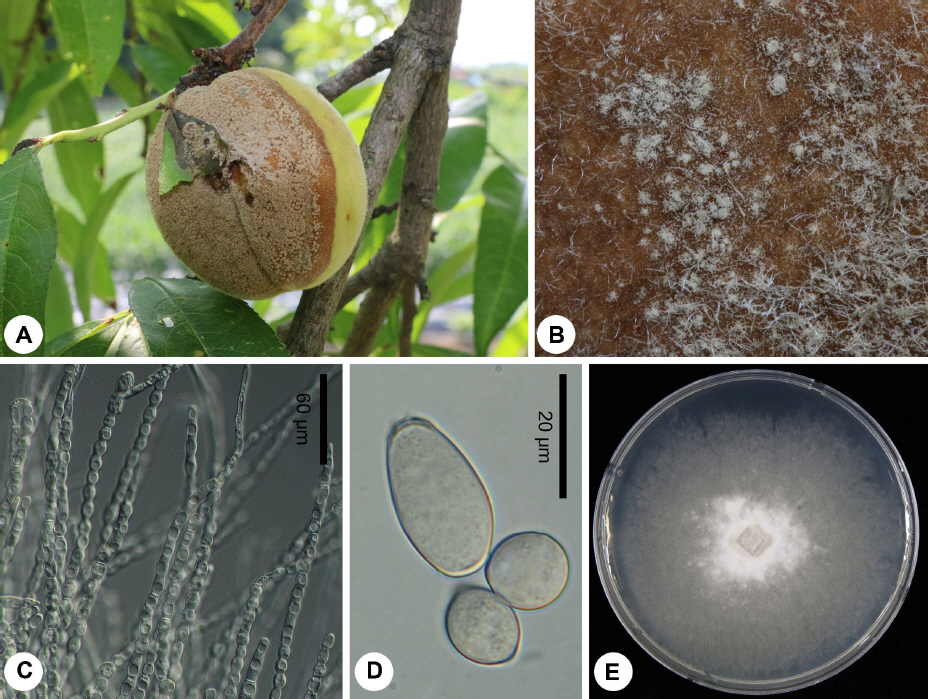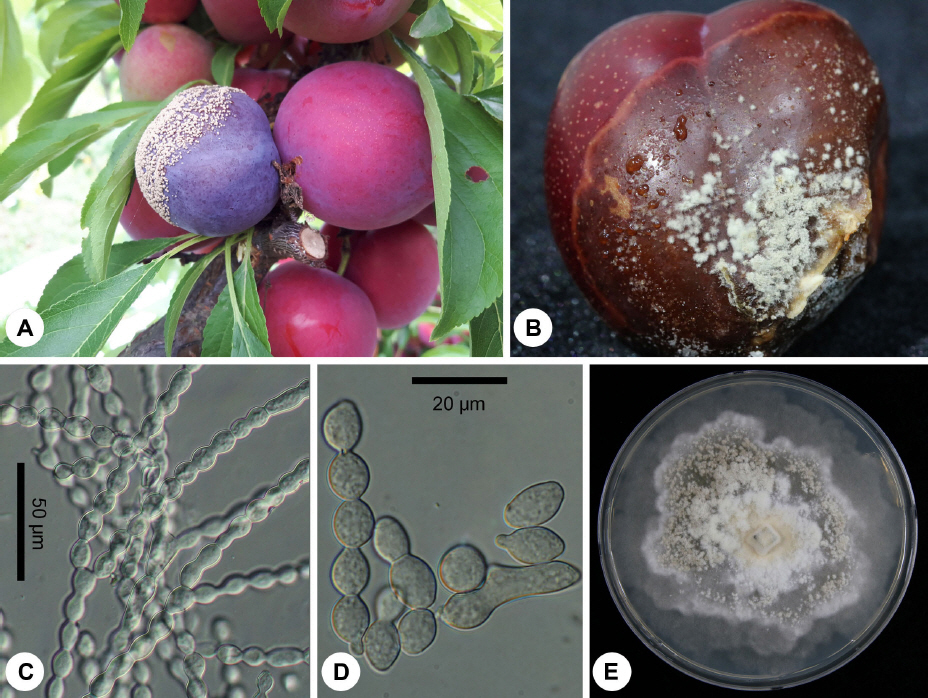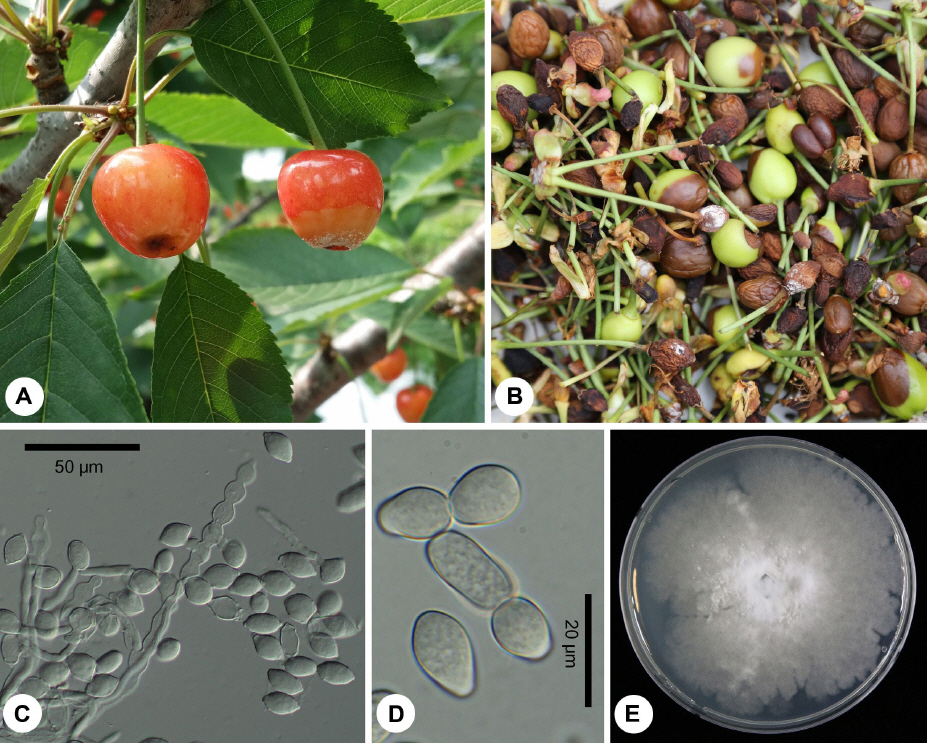Choi, I. Y, Kim, J, Seo, K. W, Oh, H. T, Cho, J. H, Kim, J. H and Song, Y. J 2016. Occurrence of brown rot on apricot caused by Monilinia fructicola in Korea.
Res. Plant Dis 22: 122-126. (In Korean)

Choi, H. W, Hong, S. K, Lee, Y. K, Nam, Y. J, Lee, J. G and Shim, H. S 2014. Characterization of Monilinia fructicola associated with brown rot of cherry fruit in Korea.
Kor. J. Mycol 42: 353-356. (In Korean)

Crous, P. W, Verkley, G. J. M, Groenewald, J. Z and Samon, R. A 2009. Fungal Biodiversity. pp. 144-146. CBS-KNAW Fungal Biodiversity Centre Utrecht, The Netherlands.
EPPO/CABI. 2010. Data sheets on quarantine pests: Monilinia fructicola.
Farr, DF and Rossman, AY Fungal Databases, Systematic Mycology & Microbiology Laboratory, ARS, USDA [Internet]. United States Department of Agriculture; Washington, DC: Cited 24th July 2017. URL
http://nt.ars-grin.gov/fungaldatabases/
Fulton, C. E and Brown, A. E 1997. Use of SSU rDNA group-I intron to distinguish Monilinia fructicola from M. laxa and M. fructigena.
FEMS Microbiol. Lett 157: 307-312.


Gell, I, De Cal, A, Torres, R, Usall, J and Melgarejo, P 2008. Relationship between the incidence of latent infections caused by Monilinia spp. and the incidence of brown rot of peach fruit: factors affecting latent infection.
Eur. J. Plant Pathol 121: 487-498.

Hu, M. J, Cox, K. D, Schnabel, G and Luo, C. X 2011. Monilinia species causing brown rot of peach in China.
PLoS One 6: e24990



Martin, J. P 1950. Use of acid, rose bengal, and streptomycin in the plate method for estimating soil fungi.
Soil Sci 69: 215-232.

Ministry of Agriculture, Food and Rural Affairs. 2010. Statistics of Cultivation and Production of Industrial Crops in 2008. Ministry of Agriculture, Food and Rural Affairs; Sejong, Korea.
Ministry of Agriculture, Food and Rural Affairs. 2017. Statistics of Cultivation and Production of Industrial Crops in 2015. Ministry of Agriculture, Food and Rural Affairs; Sejong, Korea.
Pellegrino, C, Gullino, M. L, Garibaldi, A and Spadaro, D 2009. First report of brown rot of stone fruit caused by Monilinia fructicola in Italy.
Plant Dis 93: 668

Petroczy, M and Palkovics, L 2006. First report of brown rot caused by Monilinia fructicola on imported peach in Hungary.
Plant Dis 90: 375

Rungjindamai, N, Jeffries, P and Xu, X. M 2014. Epidemiology and management of brown rot on stone fruit caused by Monilinia laxa.
Eur. J. Plant Pathol 140: 1-17.

Rural Development Administration. 2007. Monography of Stone Fruit Cultivars. Suwon, Korea. pp. 252.(In Korean)
Rural Development Administration. 2008. New Illustrated Book on Diseases. Insect Pests in Fruit Trees, Suwon, Korea. 550. (In Korean)
Saitou, N and Nei, M 1987. The neighbor-joining method: a new method for reconstructing phylogenetic trees.
Mol. Biol. Evol 4: 406-425.

Shim, M. Y, Jeon, Y. J and Kim, S. H 2007. Characterization of a brown rot fungus isolated from dwarf flowering almond in Korea.
Mycobiology 35: 30-35.



Sinclair, W. A and Lyon, H. H 2005. Diseases of Trees and Shrubs. 2nd ed pp. 76-77. Ithaca and London. Comstock Publication Associates, Cornell University Press.
Tamura, K, Stecher, G, Peterson, D, Filipski, A and Kumar, S 2013. MEGA6: Molecular Evolutionary Genetics Analysis Version 6.0.
Mol. Biol. Evol 30: 2725-2729.



The Korean Society of Plant Pathology. 2009. List of Plant Disease in Korea. 5th ed The Korean Society of Plant Pathology, Suwon, Korea. pp. 853 pp.
White, T. J, Bruns, T, Lee, S and Taylor, J 1990. Amplification anddirect sequencing of fungal ribosomal RNA genes for phylogenetics. In: PCR Protocols: A Guide to Methods and Applications. Innis, MA, Gelfand, DH, Shinski, JJ and White, TJpp. 315-322. Academic Press, San Diego, CA, USA.

Zhu, X. Q, Chen, X. Y, Luo, Y and Guo, L. Y 2005. First report of Monilinia fructicola on peach and nectarine in China.
Plant Pathol 54: 575










 PDF Links
PDF Links PubReader
PubReader Full text via DOI
Full text via DOI Download Citation
Download Citation Print
Print






